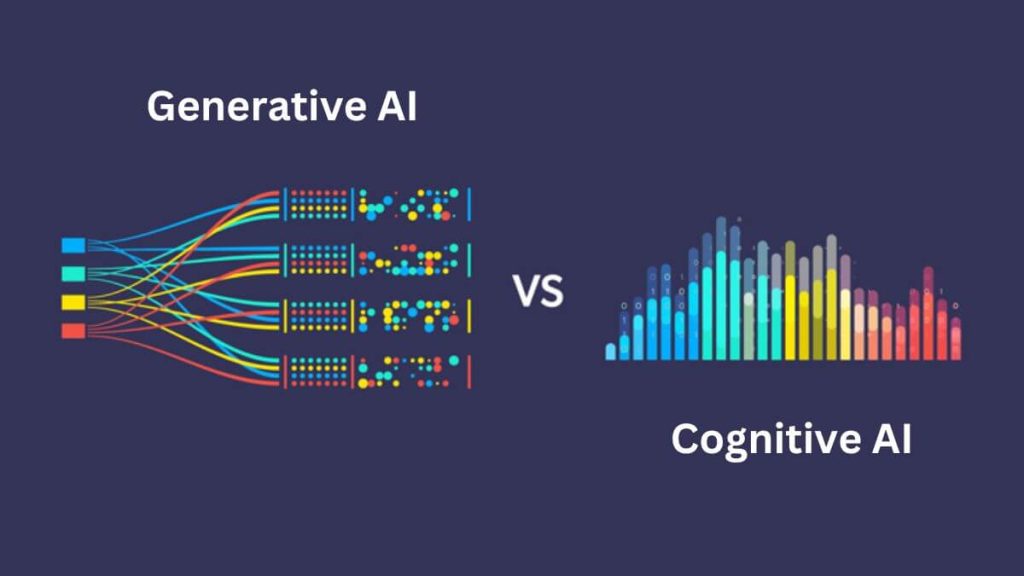Artificial Intelligence (AI) has evolved into specialized disciplines, with Generative AI and Cognitive AI standing out as two fascinating branches. Let’s explore how these AI types differ, their unique features, and their exciting applications.
What is Generative AI?
Generative AI uses deep learning techniques to create new content like images, music, or text based on patterns in large datasets. This type of AI can produce impressive outputs that mimic the data it has been trained on, making it a powerful tool in various creative and predictive tasks.
Features of Generative AI
Generative AI is designed to autonomously train itself using large datasets, allowing it to generate new and unique content. Whether it’s creating stunning artwork, composing music, or even writing text, Generative AI excels in tasks that require creativity and innovation. Its applications span across healthcare, digital marketing, and the creative industries, showcasing its versatility and potential.
Applications and Industry Trends
Generative AI is revolutionizing industries by optimizing processes and enhancing creativity. In healthcare, it aids in drug discovery and personalized medication, while in digital marketing, it helps create tailored content. The creative industry benefits from Generative AI by producing art and music, pushing the boundaries of what’s possible. Emerging trends in Generative AI focus on scaling models, multimodal learning, and unsupervised approaches, opening new possibilities in various domains.
Also read | WhatsApp Meta AI: How To Solve Math Questions In Just 1 Minute
What is Cognitive AI?
Cognitive AI aims to simulate and expand human cognitive abilities, such as reasoning, problem-solving, and decision-making. This AI type excels in natural language processing (NLP), allowing it to understand and interpret human languages with high accuracy, making it invaluable in applications requiring nuanced understanding and interaction.
Features of Cognitive AI
Cognitive AI relies on advanced machine learning algorithms to find complex patterns in large datasets. It has seen significant success in computer vision, image recognition, and facial recognition, making it highly precise and accurate. Cognitive AI adapts dynamically to changing circumstances, learning and improving over time. It also includes emotional intelligence, allowing it to recognize and respond to human emotions, enhancing interactions and understanding human behavior.
Applications and Industry Impact
Cognitive AI enhances decision-making and problem-solving across various industries. In healthcare, it assists in diagnostics and treatment planning, while in finance, it supports risk management and predictive analytics. Intelligent assistants and autonomous vehicles benefit from Cognitive AI’s ability to adapt and learn, making them more reliable and efficient.
Comparing Generative AI and Cognitive AI
Objective and Focus
Generative AI focuses on creating new content or data based on learned patterns from training datasets. It excels in mimicking or extending attributes found in the input data. In contrast, Cognitive AI seeks to replicate human cognitive capabilities, such as reasoning, problem-solving, and decision-making, across various domains.
Methods and Techniques
Generative AI primarily uses deep learning techniques like generative adversarial networks (GANs) and variational autoencoders (VAEs). These models generate outputs resembling the training data. Cognitive AI involves machine learning, NLP, computer vision, and robotics. It combines symbolic reasoning with statistical learning to understand and contextualize information.
Scope and Complexity
Generative AI, though challenging to model and train, focuses on generating new instances of data based on learned patterns. Its strength lies in its fidelity to the training data. Cognitive AI addresses broader issues requiring contextual understanding, learning from sparse data, and adaptive decision-making, modeling human cognition in diverse ways.
Also read | Top AI Music Generators in 2024
Conclusion
Generative AI and Cognitive AI serve distinct purposes within the broader landscape of artificial intelligence. Generative AI creates new content by leveraging learned patterns, making it invaluable in creative and predictive tasks. Cognitive AI replicates human-like cognitive abilities, enhancing reasoning, learning, and decision-making across various domains. Both AI types contribute significantly to advancing technology and improving efficiency in numerous fields.
FAQs
- What is Generative AI? Gen AI refers to techniques focusing on generating new content, data, or outputs based on patterns learned from training data. It uses methods like GANs and VAEs to create outputs that mimic the input data’s characteristics.
- How does Generative AI differ from Cognitive AI? Gen AI specializes in creating new content or data based on learned patterns, aiming to mimic or enhance attributes found in the training data. Cognitive AI seeks to replicate and extend human-like cognitive abilities such as reasoning, problem-solving, and decision-making across various domains.
- What are some applications of Generative AI? Gen AI finds applications in image synthesis, text generation, music composition, and data augmentation. It is particularly useful in creative industries where generating new content from existing patterns is valuable.
- What are the key techniques used in Cognitive AI? Cognitive AI integrates machine learning, natural language processing (NLP), computer vision, and robotics. It employs advanced algorithms to enable reasoning, understanding context, and adaptive learning, simulating complex cognitive functions similar to human cognition.
- How does Cognitive AI impact different industries? Cognitive AI enhances decision support systems, intelligent assistants, autonomous vehicles, and healthcare diagnostics by improving problem-solving, decision-making, and interaction capabilities. It enables applications in high-stakes industries like healthcare, finance, and customer service, promoting trust and transparency in critical decision-making processes.

